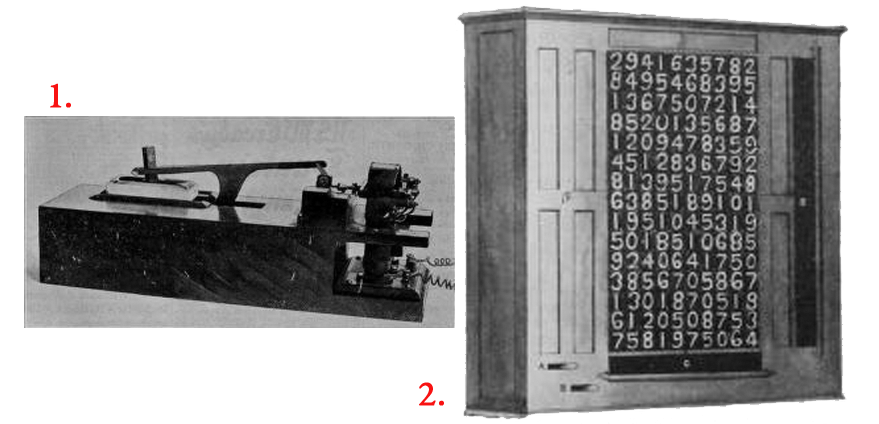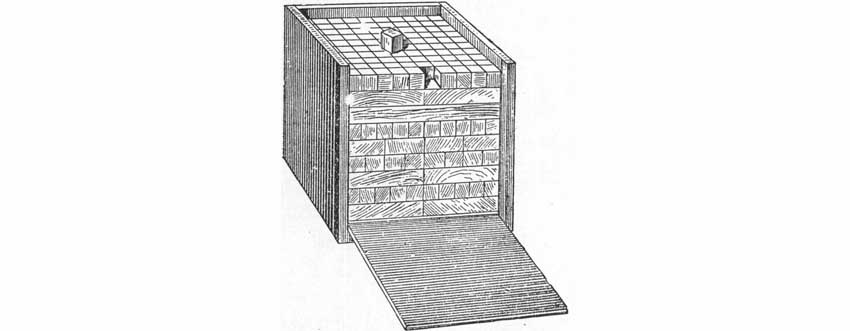Mysterious devices – 4
Still, old magazines contain a lot of interesting things, in all respects. Technical devices are especially intriguing, the purpose of which can be understood only after reading the accompanying text.
What do you think it is?

As a hint, I inform you that the photographs were found in the American calligraphic journal Penman's Art Journal of the beginning of the last century.
Thanks for attention.
Previous posts in this series:
Mysterious Stationery-1 ,
Mysterious Stationery-2 ,
Mysterious Stationery-3 .
What do you think it is?

As a hint, I inform you that the photographs were found in the American calligraphic journal Penman's Art Journal of the beginning of the last century.
Number one
This ... I did not know what Indian ink was, I had to google it. It turned out that Indian ink is the same as Chinese ink: a long-lasting suspension of carbon black mixed with shellac (I had to google again: shellac , or gummilac - a resinous substance secreted by varnish worms on shoots of tropical plants), brown (google for the third time: borax - sodium salt of boric acid, found in the form of a mineral) or with soap in water.
Here is what the source said about the device:
A calligrapher using Indian ink (and if he is an artist of his craft, he is obliged to use them), is forced to rub them for a long time. The ink stick is rubbed on a tray, in which a little water has been poured, for twenty or thirty minutes, but the amount of ink obtained in this way is still scanty. This is one of the main reasons that force calligraphers not to use Indian ink at all.
To solve the problem Journal Journalist J. F. Briley invented and patented a device known as the “Indian Ink Electric Crusher”. The crusher - its dimensions are twenty inches long, seven in height and six in width - has an electric engine with a capacity of approximately one-fifteenth horsepower, powered by four miniature batteries with a voltage of 6 volts. The cost of crushing is one cent per hour, but if there is an electric wire in the room that can be connected to the engine, the costs will be significantly reduced.
The principle of operation is the worm gear known in mechanics, making 2000 rpm. This is enough to ensure that the screw on which the ink stick is mounted makes 360 movements per minute.
Ink sticks for a dozen employees in the department in which Mr. Briley works are rubbed only in his car, which takes several minutes a day, while a specially hired worker used to do this.
The design of the device is wonderful, and if it belonged to a more common process, it would surely provide the inventor with fame and recognition.
Source .
Here is what the source said about the device:
Electricity and Calligraphy
A calligrapher using Indian ink (and if he is an artist of his craft, he is obliged to use them), is forced to rub them for a long time. The ink stick is rubbed on a tray, in which a little water has been poured, for twenty or thirty minutes, but the amount of ink obtained in this way is still scanty. This is one of the main reasons that force calligraphers not to use Indian ink at all.
To solve the problem Journal Journalist J. F. Briley invented and patented a device known as the “Indian Ink Electric Crusher”. The crusher - its dimensions are twenty inches long, seven in height and six in width - has an electric engine with a capacity of approximately one-fifteenth horsepower, powered by four miniature batteries with a voltage of 6 volts. The cost of crushing is one cent per hour, but if there is an electric wire in the room that can be connected to the engine, the costs will be significantly reduced.
The principle of operation is the worm gear known in mechanics, making 2000 rpm. This is enough to ensure that the screw on which the ink stick is mounted makes 360 movements per minute.
Ink sticks for a dozen employees in the department in which Mr. Briley works are rubbed only in his car, which takes several minutes a day, while a specially hired worker used to do this.
The design of the device is wonderful, and if it belonged to a more common process, it would surely provide the inventor with fame and recognition.
Source .
Number two
With number two, I admit, it's a little more complicated. The idea seems to be clear, but the principle of operation of this digital gizmo and, most importantly, how something can be demonstrated to students in a similar way (this is a training manual) - break the thunder, I don’t understand.
Here is the translation of the original article:
Infrequently, devices with such an unpronounceable name represent something, but it does. This is a machine six feet high, five feet long and ten inches wide, with the ability to demonstrate 373,191,840 arithmetic examples by multiplication, division, percent calculation, etc. The machine of the cabinet format is designed to save time for math teachers who can simply manipulate the fifteen numbers located in ten columns with a simple click on the lever. Millions of numerical combinations occur in concert, as a result of which errors are impossible, the demonstration of the example, like the calculation itself, is carried out with lightning speed, and the teacher is freed from writing numbers, so he pays more attention to explanations.
Almost all the details of Horton’s numerological office are steel, although for reasons of design or economy, they can be made of wood. The sizes are also possible different: the cabinet shown in the figure has numbers so large and clear that they can be read at a distance of 90 feet.
The figure shows the lever "A", with which 74,046 different numerical combinations are achieved, and the lever "B", producing 5,040 combinations. When manipulating both levers, the number of combinations increases. “C” and “E” are curtains with which you can adjust the height and length of the columns, and “D” is a pulley with a cord stretching to “C”.
Numerological office - the invention of the teacher of calligraphy L.K. Horton'sfrom New York. It seems to us that in order to produce and market this miracle of human ingenuity, a company should be organized.
Source .
Horton's numerological machine reminded me of another device for mathematics teachers, a domestic and, at least, understandable design: an arithmetic box .

I can hardly imagine how cubes can be taught in mathematics. Well, if only the initial account in kindergarten ... Although it is possible that I am in the most cruel and amateurish way mistaken about both devices. I have problems with English (as a result of which the translation is not only abbreviated, but also, let’s say, artistic), but with a technical estimate, the clinic is generally. Plus, the illegible text of the original, with which only to break eyes. Therefore, I absolutely do not mind if they correct me.
Here is the translation of the original article:
Horton Numerology Office
Infrequently, devices with such an unpronounceable name represent something, but it does. This is a machine six feet high, five feet long and ten inches wide, with the ability to demonstrate 373,191,840 arithmetic examples by multiplication, division, percent calculation, etc. The machine of the cabinet format is designed to save time for math teachers who can simply manipulate the fifteen numbers located in ten columns with a simple click on the lever. Millions of numerical combinations occur in concert, as a result of which errors are impossible, the demonstration of the example, like the calculation itself, is carried out with lightning speed, and the teacher is freed from writing numbers, so he pays more attention to explanations.
Almost all the details of Horton’s numerological office are steel, although for reasons of design or economy, they can be made of wood. The sizes are also possible different: the cabinet shown in the figure has numbers so large and clear that they can be read at a distance of 90 feet.
The figure shows the lever "A", with which 74,046 different numerical combinations are achieved, and the lever "B", producing 5,040 combinations. When manipulating both levers, the number of combinations increases. “C” and “E” are curtains with which you can adjust the height and length of the columns, and “D” is a pulley with a cord stretching to “C”.
Numerological office - the invention of the teacher of calligraphy L.K. Horton'sfrom New York. It seems to us that in order to produce and market this miracle of human ingenuity, a company should be organized.
Source .
Horton's numerological machine reminded me of another device for mathematics teachers, a domestic and, at least, understandable design: an arithmetic box .

I can hardly imagine how cubes can be taught in mathematics. Well, if only the initial account in kindergarten ... Although it is possible that I am in the most cruel and amateurish way mistaken about both devices. I have problems with English (as a result of which the translation is not only abbreviated, but also, let’s say, artistic), but with a technical estimate, the clinic is generally. Plus, the illegible text of the original, with which only to break eyes. Therefore, I absolutely do not mind if they correct me.
Thanks for attention.
Previous posts in this series:
Mysterious Stationery-1 ,
Mysterious Stationery-2 ,
Mysterious Stationery-3 .
